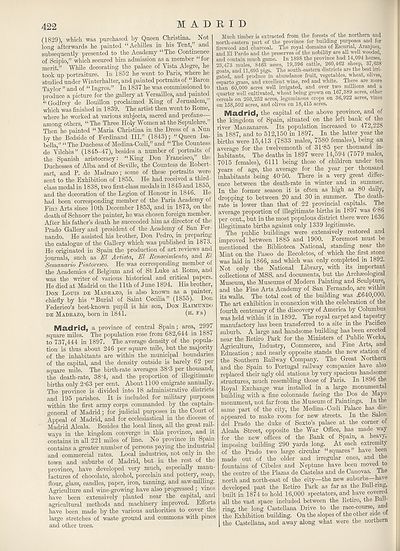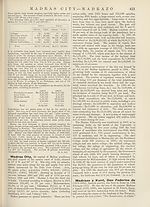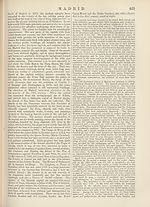New volumes of the Encyclopædia Britannica > Volume 30, K-MOR
(452) Page 422
Download files
Complete book:
Individual page:
Thumbnail gallery: Grid view | List view

MADRID
422
(1829), which was purchased by Queen Christina. Not
long afterwards he painted ‘1 Achilles in his Tent,, and
subsequently presented to the Academy ‘ The Continence
of Scipio,” which secured him admission as a member “ for
merit.” Vhile decorating the palace of Vista Alegre, he
took up portraiture. In 1852 he went to Paris, where he
studied under Winterhalter, and painted portraits of “Baron
Taylor ” and of “ Ingres.” In 1837 he was commissioned to
produce a picture for the gallery at Versailles, and painted
“Godfrey de Bouillon proclaimed King of Jerusalem,”
which was finished in 1839. The artist then went to Rome,
where he worked at various subjects, sacred and profane—
among others, “ The Three Holy Women at the Sepulchre.”
Then he painted “ Maria Christina in the Dress of a Nun
by the Bedside of Ferdinand III.” (1843); “Queen Isa¬
bella,” “ The Duchess of Medina-Cceli,” and “ The Countess
de Vilches” (1845-47), besides a number of portraits of
the Spanish aristocracy: “King Don Francisco,” the
Duchesses of Alba and of Seville, the Countess de.Robert-
sart, and P. de Madrazo ; some of these portraits were
sent to the Exhibition of 1855. He had received a third-
class medal in 1838, two first-class medals in 1845 and 1855,
and the decoration of the Legion of Honour in 1846. He
had been corresponding member of the Paris Academy ol
Fine Arts since 10th December 1853, and in 1873, on the
death of Schnorr the painter, he was chosen foreign member.
After his father’s death he succeeded him as director of the
Prado Gallery and president of the Academy of San Fer¬
nando. He assisted his brother, Don Pedro, in preparing
the catalogue of the Gallery which was published in 1873.
He originated in Spain the production of art reviews and
journals, such as A/ Artista, El Renciciwiento, and El
Semanario Pintoresco. He was corresponding member of
the Academies of Belgium and of St Luke at Rome, and
was the writer of various historical and critical papers.
He died at Madrid on the 11th of June 1894. His brother,
Don Louis de Madrazo, is also known as a painter,
chiefly by his “Burial of Saint Cecilia” (1855). Don
Federico’s best-known pupil is his son, Don Raimundo
de Madrazo, born in 1841. (H- FR)
Madrid, a province of central Spain; area, 299^
square miles. The population rose from 682,644 in 188/
to 737,444 in 1897. The average density of the popula¬
tion is thus about 246 per square mile, but the majority
of the inhabitants are within the municipal boundaries
of the capital, and the density outside is barely 62 per
square mile. The birth-rate averages 38‘3 per thousand,
the death-rate, 38-4, and the proportion of illegitimate
births only 2*63 per cent. About 1100 emigrate annually.
The province is divided into 18 administrative districts
and 195 parishes. It is included for military purposes
within the first army corps commanded by the captain-
general of Madrid; for judicial purposes in the Court of
Appeal of Madrid, and for ecclesiastical in the diocese of
Madrid Alcala. Besides the local lines, all the great rail¬
ways in the kingdom converge in this province, and it
contains in all 221 miles of line. No province in Spain
contains a greater number of persons paying the industrial
and commercial rates. Local industries, not only in the
town and suburbs of Madrid, but in the rest of the
province, have developed very much, especially manu¬
factures of chocolate, alcohol, porcelain and pottery, soap,
flour, glass, candles, paper, iron, tanning, and saw-milling.
Agriculture and wine-growing have also progressed; vines
have been extensively planted near the capital, and
agricultural methods and machinery improved. Efforts
have been made by the various authorities to cover the
large stretches of waste ground and commons with pines
and other trees.
Much timber is extracted from the forests of the northern and
north-eastern part of the province for building purposes and for
firewood and charcoal. The royal domains of Escurial, Aranjuez,
and El Pardo and the preserves of the nobility are all well wooded,
and contain much game. In 1898 the province had 14,094 horses,
23,473 mules, 8463 asses, 19,396 cattle, 260,462 sheep, 37,638
goats, and 11,695 pigs. The south-eastern districts are the best irri¬
gated, and produce in abundance fruit, vegetables, wheat, olives,
esparto grass, and excellent wdne, red and white. There are more
than 60,000 acres well irrigated, and over two millions and a
quarter well cultivated, wheat being grown on 16/,389 acres, other
cereals on 203,252 acres, leguminous crops on 36,922 acres, vines
on 158,502 acres, and olives on 18,415 acres.
Madrid, the capital of the above province, and of
the kingdom of Spain, situated on the left bank of the
river Manzanares. Its population increased to 472,228
in 1887, and to 512,150 in 1897. In the latter year the
births were 15,413 (7833 males, 7580 females), being an
average for the twelvemonth of 31'85 per thousand in¬
habitants. The deaths in 1897 were 14,594 (/ 5 / 9 males,
7015 females), 6111 being those of children under ten
years of age, the average for the year per thousand
inhabitants being 40-50. There is a very great differ¬
ence between the death-rate in winter and in summer.
In the former season it is often as high as 80 daily,
dropping to between 20 and 30 in summer. The death-
rate is lower than that of 22 provincial capitals. The
average proportion of illegitimate births in 189/ was 6'86
per cent., but in the most populous district there were 1636
illegitimate births against only 1339 legitimate.
The public buildings were extensively restored and
improved between 1885 and 1900. Foremost must be
mentioned the Biblioteca National, standing near the
Mint on the Paseo de Recoletos, of which the first stone
was laid in 1866, and which was only completed in 1892.
Not only the National Library, with its important
collections of MSS. and documents, but the Archaeological
Museum, the Museums of Modern Painting and Sculpture,
and the Fine Arts Academy of San Fernando, are within
its walls. The total cost of the building was £640,000.
The art exhibition in connexion with the celebration of the
fourth centenary of the discovery of America by Columbus
was held within it in 1892. The royal carpet and tapestry
manufactory has been transferred to a site in the Pacifico
suburb. A large and handsome building has been erected
near the Retiro Park for the Ministers of Public Works,
Agriculture, Industry, Commerce, and Fine Arts, and
Education ; and nearly opposite stands the new station of
the Southern Railway Company. The Great Northern
and the Spain to Portugal railway companies have also
replaced their ugly old stations by very spacious handsome
structures, much resembling those of Paris. In 1896 the
Royal Exchange was installed in a large monumental
building with a fine colonnade facing the Dos de Mayo
monument, not far from the Museum of Paintings. In the
same part of the city, the Medina-Coeli Palace has dis¬
appeared to make room for new streets. In the Salon
del Prado the duke of Sexto’s palace at the corner of
Alcala Street, opposite the War Office, has made way
for the new offices of the Bank of Spain, a heavy,
imposing building 290 yards long. At each extremity
of the Prado two large circular “squares” have been
made out of the older and irregular ones, and the
fountains of Cibeles and Neptune have been moved to
the centre of the Plazas de Castelas and de Canovas. The
north and north-east of the city—the new suburbs—have
developed past the Retiro Park as far as the Bull-ring,
built in 1874 to hold 16,000 spectators, and have covered
all the vast space included between the Retiro, the Bulb
ring, the long Castellana Drive to the race-course, and
the Exhibition building. On the slopes of the other side of
[ the Castellana, and away along what were the northern
422
(1829), which was purchased by Queen Christina. Not
long afterwards he painted ‘1 Achilles in his Tent,, and
subsequently presented to the Academy ‘ The Continence
of Scipio,” which secured him admission as a member “ for
merit.” Vhile decorating the palace of Vista Alegre, he
took up portraiture. In 1852 he went to Paris, where he
studied under Winterhalter, and painted portraits of “Baron
Taylor ” and of “ Ingres.” In 1837 he was commissioned to
produce a picture for the gallery at Versailles, and painted
“Godfrey de Bouillon proclaimed King of Jerusalem,”
which was finished in 1839. The artist then went to Rome,
where he worked at various subjects, sacred and profane—
among others, “ The Three Holy Women at the Sepulchre.”
Then he painted “ Maria Christina in the Dress of a Nun
by the Bedside of Ferdinand III.” (1843); “Queen Isa¬
bella,” “ The Duchess of Medina-Cceli,” and “ The Countess
de Vilches” (1845-47), besides a number of portraits of
the Spanish aristocracy: “King Don Francisco,” the
Duchesses of Alba and of Seville, the Countess de.Robert-
sart, and P. de Madrazo ; some of these portraits were
sent to the Exhibition of 1855. He had received a third-
class medal in 1838, two first-class medals in 1845 and 1855,
and the decoration of the Legion of Honour in 1846. He
had been corresponding member of the Paris Academy ol
Fine Arts since 10th December 1853, and in 1873, on the
death of Schnorr the painter, he was chosen foreign member.
After his father’s death he succeeded him as director of the
Prado Gallery and president of the Academy of San Fer¬
nando. He assisted his brother, Don Pedro, in preparing
the catalogue of the Gallery which was published in 1873.
He originated in Spain the production of art reviews and
journals, such as A/ Artista, El Renciciwiento, and El
Semanario Pintoresco. He was corresponding member of
the Academies of Belgium and of St Luke at Rome, and
was the writer of various historical and critical papers.
He died at Madrid on the 11th of June 1894. His brother,
Don Louis de Madrazo, is also known as a painter,
chiefly by his “Burial of Saint Cecilia” (1855). Don
Federico’s best-known pupil is his son, Don Raimundo
de Madrazo, born in 1841. (H- FR)
Madrid, a province of central Spain; area, 299^
square miles. The population rose from 682,644 in 188/
to 737,444 in 1897. The average density of the popula¬
tion is thus about 246 per square mile, but the majority
of the inhabitants are within the municipal boundaries
of the capital, and the density outside is barely 62 per
square mile. The birth-rate averages 38‘3 per thousand,
the death-rate, 38-4, and the proportion of illegitimate
births only 2*63 per cent. About 1100 emigrate annually.
The province is divided into 18 administrative districts
and 195 parishes. It is included for military purposes
within the first army corps commanded by the captain-
general of Madrid; for judicial purposes in the Court of
Appeal of Madrid, and for ecclesiastical in the diocese of
Madrid Alcala. Besides the local lines, all the great rail¬
ways in the kingdom converge in this province, and it
contains in all 221 miles of line. No province in Spain
contains a greater number of persons paying the industrial
and commercial rates. Local industries, not only in the
town and suburbs of Madrid, but in the rest of the
province, have developed very much, especially manu¬
factures of chocolate, alcohol, porcelain and pottery, soap,
flour, glass, candles, paper, iron, tanning, and saw-milling.
Agriculture and wine-growing have also progressed; vines
have been extensively planted near the capital, and
agricultural methods and machinery improved. Efforts
have been made by the various authorities to cover the
large stretches of waste ground and commons with pines
and other trees.
Much timber is extracted from the forests of the northern and
north-eastern part of the province for building purposes and for
firewood and charcoal. The royal domains of Escurial, Aranjuez,
and El Pardo and the preserves of the nobility are all well wooded,
and contain much game. In 1898 the province had 14,094 horses,
23,473 mules, 8463 asses, 19,396 cattle, 260,462 sheep, 37,638
goats, and 11,695 pigs. The south-eastern districts are the best irri¬
gated, and produce in abundance fruit, vegetables, wheat, olives,
esparto grass, and excellent wdne, red and white. There are more
than 60,000 acres well irrigated, and over two millions and a
quarter well cultivated, wheat being grown on 16/,389 acres, other
cereals on 203,252 acres, leguminous crops on 36,922 acres, vines
on 158,502 acres, and olives on 18,415 acres.
Madrid, the capital of the above province, and of
the kingdom of Spain, situated on the left bank of the
river Manzanares. Its population increased to 472,228
in 1887, and to 512,150 in 1897. In the latter year the
births were 15,413 (7833 males, 7580 females), being an
average for the twelvemonth of 31'85 per thousand in¬
habitants. The deaths in 1897 were 14,594 (/ 5 / 9 males,
7015 females), 6111 being those of children under ten
years of age, the average for the year per thousand
inhabitants being 40-50. There is a very great differ¬
ence between the death-rate in winter and in summer.
In the former season it is often as high as 80 daily,
dropping to between 20 and 30 in summer. The death-
rate is lower than that of 22 provincial capitals. The
average proportion of illegitimate births in 189/ was 6'86
per cent., but in the most populous district there were 1636
illegitimate births against only 1339 legitimate.
The public buildings were extensively restored and
improved between 1885 and 1900. Foremost must be
mentioned the Biblioteca National, standing near the
Mint on the Paseo de Recoletos, of which the first stone
was laid in 1866, and which was only completed in 1892.
Not only the National Library, with its important
collections of MSS. and documents, but the Archaeological
Museum, the Museums of Modern Painting and Sculpture,
and the Fine Arts Academy of San Fernando, are within
its walls. The total cost of the building was £640,000.
The art exhibition in connexion with the celebration of the
fourth centenary of the discovery of America by Columbus
was held within it in 1892. The royal carpet and tapestry
manufactory has been transferred to a site in the Pacifico
suburb. A large and handsome building has been erected
near the Retiro Park for the Ministers of Public Works,
Agriculture, Industry, Commerce, and Fine Arts, and
Education ; and nearly opposite stands the new station of
the Southern Railway Company. The Great Northern
and the Spain to Portugal railway companies have also
replaced their ugly old stations by very spacious handsome
structures, much resembling those of Paris. In 1896 the
Royal Exchange was installed in a large monumental
building with a fine colonnade facing the Dos de Mayo
monument, not far from the Museum of Paintings. In the
same part of the city, the Medina-Coeli Palace has dis¬
appeared to make room for new streets. In the Salon
del Prado the duke of Sexto’s palace at the corner of
Alcala Street, opposite the War Office, has made way
for the new offices of the Bank of Spain, a heavy,
imposing building 290 yards long. At each extremity
of the Prado two large circular “squares” have been
made out of the older and irregular ones, and the
fountains of Cibeles and Neptune have been moved to
the centre of the Plazas de Castelas and de Canovas. The
north and north-east of the city—the new suburbs—have
developed past the Retiro Park as far as the Bull-ring,
built in 1874 to hold 16,000 spectators, and have covered
all the vast space included between the Retiro, the Bulb
ring, the long Castellana Drive to the race-course, and
the Exhibition building. On the slopes of the other side of
[ the Castellana, and away along what were the northern
Set display mode to:
![]() Universal Viewer |
Universal Viewer | ![]() Mirador |
Large image | Transcription
Mirador |
Large image | Transcription
Images and transcriptions on this page, including medium image downloads, may be used under the Creative Commons Attribution 4.0 International Licence unless otherwise stated. ![]()
| Encyclopaedia Britannica > New volumes of the Encyclopædia Britannica > Volume 30, K-MOR > (452) Page 422 |
|---|
| Permanent URL | https://digital.nls.uk/193573377 |
|---|
| Attribution and copyright: |
|
|---|---|
| Shelfmark | EB.18 |
|---|---|
| Description | Ten editions of 'Encyclopaedia Britannica', issued from 1768-1903, in 231 volumes. Originally issued in 100 weekly parts (3 volumes) between 1768 and 1771 by publishers: Colin Macfarquhar and Andrew Bell (Edinburgh); editor: William Smellie: engraver: Andrew Bell. Expanded editions in the 19th century featured more volumes and contributions from leading experts in their fields. Managed and published in Edinburgh up to the 9th edition (25 volumes, from 1875-1889); the 10th edition (1902-1903) re-issued the 9th edition, with 11 supplementary volumes. |
|---|---|
| Additional NLS resources: |
|

